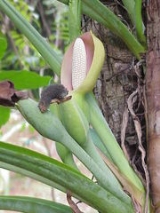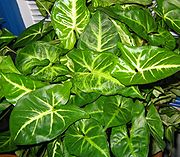
Syngonium
Encyclopedia
Syngonium s is a genus
of about 36 species
of flowering plant
s in the family Araceae
, native to tropical rain forests in Central
and South America
. They are woody vine
s growing to heights of 10–20 m or more in trees. They have leaves
that change shape according to the plant's stage of growth, and adult leaf forms are often much more lobed than the juvenile
forms usually seen on small house plants.
16 °C
to 18 °C (60 to 65°F
) must be maintained, rising to 20 °C to 30 °C (68 to 86°F) during the growing season. They require high humidity
, including misting the leaves regularly, and good light, but not direct sunlight; they will tolerate low light levels. Water freely from spring to autumn, sparingly in winter. Feed regularly in spring and summer. If juvenile foliage is preferred, cut off all the climbing stems
that develop — the plant will remain bushy, rather than climb, and the leaves will be more arrow-shaped. Repot every second spring. Propagation
is by cuttings or air layering.
 Syngonium podophyllum is the most commonly cultivated species, being used as a houseplant since the late 19th century. It was originally confused with the similar-looking African genus Nephthytis
Syngonium podophyllum is the most commonly cultivated species, being used as a houseplant since the late 19th century. It was originally confused with the similar-looking African genus Nephthytis
, and this is still used as a common name for the plant. It was given its own genus in 1879.http://www.arhomeandgarden.org/plantoftheweek/articles/Arrowhead_Philodendron.htm Other names include:
There are several variegated cultivar
s, the main differences being in the position and extent of the cream or white markings. Some leaves are almost entirely white
, pink
or yellow
. All parts of the plant are poisonous and cause severe mouth pain if eaten.http://www.ces.ncsu.edu/depts/hort/consumer/poison/Syngopo.htm
Genus
In biology, a genus is a low-level taxonomic rank used in the biological classification of living and fossil organisms, which is an example of definition by genus and differentia...
of about 36 species
Species
In biology, a species is one of the basic units of biological classification and a taxonomic rank. A species is often defined as a group of organisms capable of interbreeding and producing fertile offspring. While in many cases this definition is adequate, more precise or differing measures are...
of flowering plant
Flowering plant
The flowering plants , also known as Angiospermae or Magnoliophyta, are the most diverse group of land plants. Angiosperms are seed-producing plants like the gymnosperms and can be distinguished from the gymnosperms by a series of synapomorphies...
s in the family Araceae
Araceae
Araceae are a family of monocotyledonous flowering plants in which flowers are borne on a type of inflorescence called a spadix. The spadix is usually accompanied by, and sometimes partially enclosed in, a spathe or leaf-like bract. Also known as the Arum family, members are often colloquially...
, native to tropical rain forests in Central
Central America
Central America is the central geographic region of the Americas. It is the southernmost, isthmian portion of the North American continent, which connects with South America on the southeast. When considered part of the unified continental model, it is considered a subcontinent...
and South America
South America
South America is a continent situated in the Western Hemisphere, mostly in the Southern Hemisphere, with a relatively small portion in the Northern Hemisphere. The continent is also considered a subcontinent of the Americas. It is bordered on the west by the Pacific Ocean and on the north and east...
. They are woody vine
Vine
A vine in the narrowest sense is the grapevine , but more generally it can refer to any plant with a growth habit of trailing or scandent, that is to say climbing, stems or runners...
s growing to heights of 10–20 m or more in trees. They have leaves
Leaf
A leaf is an organ of a vascular plant, as defined in botanical terms, and in particular in plant morphology. Foliage is a mass noun that refers to leaves as a feature of plants....
that change shape according to the plant's stage of growth, and adult leaf forms are often much more lobed than the juvenile
Juvenile (organism)
A juvenile is an individual organism that has not yet reached its adult form, sexual maturity or size. Juveniles sometimes look very different from the adult form, particularly in terms of their colour...
forms usually seen on small house plants.
Cultivation
Syngonium species are often grown as house plants, usually only in the juvenile foliage stages. For successful growth, a winter minimum temperatureTemperature
Temperature is a physical property of matter that quantitatively expresses the common notions of hot and cold. Objects of low temperature are cold, while various degrees of higher temperatures are referred to as warm or hot...
16 °C
Celsius
Celsius is a scale and unit of measurement for temperature. It is named after the Swedish astronomer Anders Celsius , who developed a similar temperature scale two years before his death...
to 18 °C (60 to 65°F
Fahrenheit
Fahrenheit is the temperature scale proposed in 1724 by, and named after, the German physicist Daniel Gabriel Fahrenheit . Within this scale, the freezing of water into ice is defined at 32 degrees, while the boiling point of water is defined to be 212 degrees...
) must be maintained, rising to 20 °C to 30 °C (68 to 86°F) during the growing season. They require high humidity
Humidity
Humidity is a term for the amount of water vapor in the air, and can refer to any one of several measurements of humidity. Formally, humid air is not "moist air" but a mixture of water vapor and other constituents of air, and humidity is defined in terms of the water content of this mixture,...
, including misting the leaves regularly, and good light, but not direct sunlight; they will tolerate low light levels. Water freely from spring to autumn, sparingly in winter. Feed regularly in spring and summer. If juvenile foliage is preferred, cut off all the climbing stems
Plant stem
A stem is one of two main structural axes of a vascular plant. The stem is normally divided into nodes and internodes, the nodes hold buds which grow into one or more leaves, inflorescence , conifer cones, roots, other stems etc. The internodes distance one node from another...
that develop — the plant will remain bushy, rather than climb, and the leaves will be more arrow-shaped. Repot every second spring. Propagation
Plant propagation
Plant propagation is the process of creating new plants from a variety of sources: seeds, cuttings, bulbs and other plant parts. Plant propagation can also refer to the artificial or natural dispersal of plants.-Sexual propagation :...
is by cuttings or air layering.
Syngonium podophyllum

Nephthytis
Nephthytis is a genus of eight species of flowering plants in the family Araceae, native to tropical western Africa, with one recently discovered disjunct species in Borneo....
, and this is still used as a common name for the plant. It was given its own genus in 1879.http://www.arhomeandgarden.org/plantoftheweek/articles/Arrowhead_Philodendron.htm Other names include:
- Arrowhead plant
- Arrowhead vine
- Arrowhead PhilodendronPhilodendronPhilodendron is a large genus of flowering plants in the Araceae family, consisting of close to 900 or more species according to TROPICOS . Other sources quote different numbers of species. According to S.J. Mayo there are about 350-400 formally recognized species whereas according to Croat there...
- Goosefoot
- African evergreenhttp://www.desert-tropicals.com/Plants/Araceae/Syngonium_podophyllum.html
There are several variegated cultivar
Cultivar
A cultivar'Cultivar has two meanings as explained under Formal definition. When used in reference to a taxon, the word does not apply to an individual plant but to all those plants sharing the unique characteristics that define the cultivar. is a plant or group of plants selected for desirable...
s, the main differences being in the position and extent of the cream or white markings. Some leaves are almost entirely white
White
White is a color, the perception of which is evoked by light that stimulates all three types of color sensitive cone cells in the human eye in nearly equal amounts and with high brightness compared to the surroundings. A white visual stimulation will be void of hue and grayness.White light can be...
, pink
Pink
Pink is a mixture of red and white. Commonly used for Valentine's Day and Easter, pink is sometimes referred to as "the color of love." The use of the word for the color known today as pink was first recorded in the late 17th century....
or yellow
Yellow
Yellow is the color evoked by light that stimulates both the L and M cone cells of the retina about equally, with no significant stimulation of the S cone cells. Light with a wavelength of 570–590 nm is yellow, as is light with a suitable mixture of red and green...
. All parts of the plant are poisonous and cause severe mouth pain if eaten.http://www.ces.ncsu.edu/depts/hort/consumer/poison/Syngopo.htm
Selected species
- Syngonium angustatum
- Syngonium angustifolium
- Syngonium armigerum
- Syngonium atrovirens
- Syngonium auritum
- Syngonium chiapense
- Syngonium chocoanum
- Syngonium crassifolium
- Syngonium dodsonianumSyngonium dodsonianumSyngonium dodsonianum is a species of plant in the Araceae family. It is endemic to Ecuador. Its natural habitat is subtropical or tropical moist lowland forests. It is threatened by habitat loss.-Source:...
- Syngonium erythrophyllum
- Syngonium foreroanum
- Syngonium gentryanum
- Syngonium glaucopetiolatum
- Syngonium harlingianumSyngonium harlingianumSyngonium harlingianum is a species of plant in the Araceae family. It is endemic to Ecuador. Its natural habitat is subtropical or tropical moist montanes. It is threatened by habitat loss.-Source:...
- Syngonium hastiferum
- Syngonium hastifolium
- Syngonium hoffmannii
- Syngonium laterinervium
- Syngonium llanoense
- Syngonium macrophyllum
- Syngonium mauroanum
- Syngonium meridense
- Syngonium neglectum
- Syngonium oduberi
- Syngonium podophyllum
- Syngonium salvadorense
- Syngonium schottianum
- Syngonium sparreorumSyngonium sparreorumSyngonium sparreorum is a species of plant in the Araceae family. It is endemic to Ecuador. Its natural habitat is subtropical or tropical moist montanes. It is threatened by habitat loss.-Source:...
- Syngonium standleyanum
- Syngonium steyermarkii
- Syngonium triphyllum
- Syngonium wendlandii
- Syngonium yurimaguense

